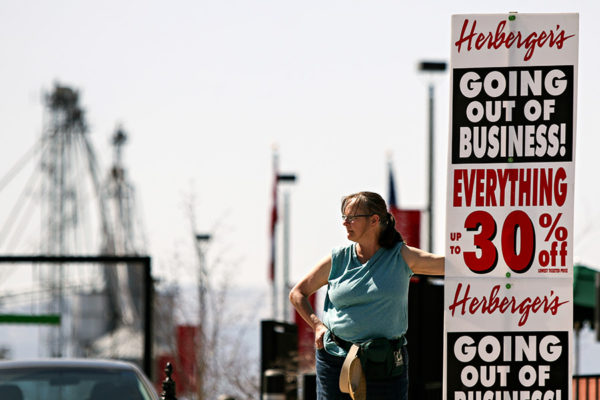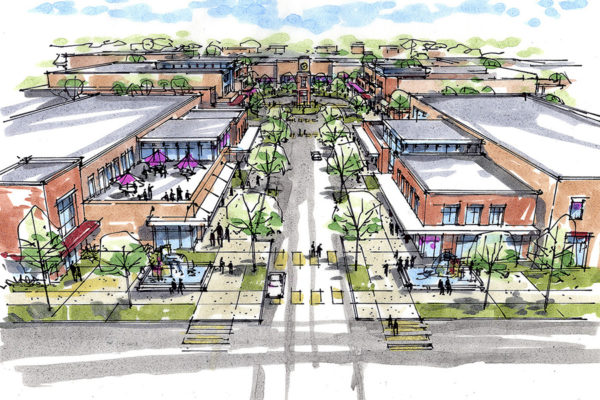For decades, the Kalispell Herberger’s was a successful department store. The retailer, one of Kalispell Center Mall’s original tenants, completed a massive expansion in 2017 that doubled its size to 80,000 square feet, making it one of the largest entities at the downtown shopping center, second only to the Red Lion Hotel.
But despite that success, “Store Closing” signs are still hanging at the front door, after the store’s parent company, Bon-Ton Stores, filed for bankruptcy last month. The shuttering comes at a unique time for shopping malls, the national retail landscape and the Kalispell Center Mall itself.
Across the country, malls are suffering as shopping habits change and online retailers like Amazon control a bigger share of the American wallet. The closing of an anchor store like Herberger’s often foretells doom for a shopping mall, but local officials are confident the Kalispell Center Mall can buck the national trend thanks in-part to the city’s core-area redevelopment plan that promises to dramatically reshape the community.
Centralized markets date back centuries, but the shopping mall is a uniquely American phenomenon fueled by post-World War II prosperity in the mid-20th century and a more mobile middle class bound for the suburbs. The enclosed shopping mall was the brainchild of Victor Gruen, known to urban planners as “the father of the modern shopping mall.” Gruen was an Austrian-born architect who envisioned malls as a community space where commerce, art and entertainment could intermingle. His first mall opened in suburban Minneapolis in 1956 with fountains, art installations and plenty of retail space. It was, however, a departure from Gruen’s original plan, which included a school, a doctor’s office and residences.
By 1970, there were 300 enclosed shopping malls across the country, but much to Gruen’s dismay they had become cathedrals to commercialism instead of community. Suburban shopping malls also began to compete head to head with downtown retail businesses. As more department stores moved to the mall, Main Streets across America emptied out. In 1978, just two years before his death, Gruen disowned what the shopping mall had become.
“I am often called the father of the shopping mall,” he said. “I would like to take this opportunity to disclaim paternity once and for all. I refuse to pay alimony to those bastard developments. They destroyed our cities.”

The roots of Kalispell’s mall date back to the early 1980s when a market study showed that the Flathead Valley was losing shoppers to larger cities, including Missoula, Great Falls and Spokane. A group of developers originally proposed putting a mall north of Kalispell Regional Medical Center, not far from today’s Blue Cow Car Wash. That effort faltered at about the same time a second group, led by Burlington Northern Railroad’s landholding subsidiary Glacier Park Co. and Spokane-based development company Goodale and Barbieri, proposed building a 170,000-square-foot mall at the site of the old railroad yard just west of U.S. Highway 93. Despite objections from other local businesses, particularly businesses located along Center Street that were evicted to make way for the mall, the Kalispell City Council green-lit the project. The Kalispell Center Mall opened in 1986.
The mall was eventually purchased by Red Lion Hotel, which was expanding its property portfolio. In 2013, Red Lion sold the mall back to its original developer, Goodale and Barbieri, for $11.6 million and signed a long-term lease to maintain its hotel on the east side of the mall. Today, the shopping center includes 300,000 square feet of space and maintains an exceptionally high occupancy rate, usually well above 90 percent, a statistic that seems to defy national trends.
Between 1970 and 2015, the number of malls in the United States grew at a rate twice as fast as the population, but the trend slowed at the beginning of the 21st century. The last new enclosed shopping mall in the United States was built in 2014, an 862,000-square-foot facility in Sarasota, Florida. Today, there are about 1,200 enclosed malls operating in the United States, but economists believe that number will sharply decline in the coming decade. A 2017 report from Credit Suisse, a financial services company, stated that 25 percent of malls could close within the next five years. Many of the closures are spurred by the bankruptcy of a number of major retail outlets as American shopping habits change.
The biggest culprit is the rise of online shopping. According to a 2017 story in The Atlantic, from 2010 to 2017 Amazon’s North American sales skyrocketed from $16 billion to $80 billion annually. The Internet has also altered shopping for people who still enjoy making big purchases in a store. In the past, people looking to purchase a couch or television often made multiple trips to a shopping center to assess their options, stopping at other nearby stores in the process and making smaller purchases. Now, most shoppers do their research online before going to the store.
Another factor is that Americans are choosing to spend more money on dining out or travel. According to that same 2017 story in The Atlantic, since 2005 sales at restaurants, bars and other food and drink-related establishments have grown twice as fast as all other retail spending.
Those shifting habits have rippled across the retail landscape, and in 2017 more than 20 major retail chains declared bankruptcy in the United States, including well-known names like RadioShack and Toys “R” Us.

The bankruptcy and closure of a well-known anchor store frequently has an enormous impact on a shopping center. Some smaller retailers at shopping centers have co-tenancy agreements that allow them to break lease agreements if a major retailer — a store like Herberger’s or JCPenney that brings in the most shoppers — closes its doors.
Despite the closure of Herberger’s, however, Kalispell Center Mall Property Manager and Marketing Director Eric Peterson has reasons to be optimistic.
While it’s unclear when Herberger’s will officially close its Kalispell location, Peterson said the recently expanded 80,000-square-foot store could quickly and easily be adapted for a new tenant.
“This could be a turn-key operation for a potential tenant, and it’s a really good-sized department store for our market,” Peterson said. “Someone could walk in, flip the switches on, put some racks up and start operations pretty quickly.”
Peterson said he is already in discussions with new prospective tenants. And while the department store is on its way out, a new women’s cosmetic store, Sephora, is opening its doors this week in another part of the mall.
Perhaps the biggest reason for optimism is a plan to redevelop the core area of town. With the expected completion of the Glacier Rail Park later this year, the railroad tracks through downtown will be ripped up and replaced with a walking path that will stretch from Woodland Park to Meridian Road, passing directly behind the mall and vast swaths of underutilized land in the heart of Kalispell. The mall owns a large section of land directly north of the railroad tracks that is prime for development, Peterson said. The SunRift Beer Company recently opened on the north side, perhaps foreshadowing what’s to come.
Kalispell City Planner Tom Jentz has called the plan to redevelop the core area “transformative” and that the plan’s key to success is intelligently incorporating facilities like the mall with new developments. Jentz said current planning trends lean toward mixed use, with multiple-story buildings that feature commercial space on the ground floor and residential space above. To help encourage such development, the city rezoned the core area to encourage a more “urban” style of development that looks and feels more like a downtown. To accomplish that, the city eliminated rules in the core area that required certain setbacks, meaning an owner can now build right up to the property line. Height and parking restrictions have also been eliminated. Jentz said if everything goes right, the trail will encourage development.
“If we set the table well, it will develop well,” he said.

Jentz would like to see the mall remodeled to be more accessible on the north side, where the trail runs, but said that’s up to the mall’s owners. Peterson said building additional entrances on the north side of the mall is an option and noted that the recent Herberger’s addition took future north-side developments and entrances into consideration.
Jerry Meerkatz, president and CEO of Montana West Economic Development, has been heavily involved in the core area redevelopment and said the mall is key to that effort.
“In general, malls are on the decline, but here in Kalispell the mall is a key pillar of the community,” he said, “and it can still be a pillar if we develop the land around it in a way that complements the mall.”
Meerkatz said while the closing of Herberger’s was “devastating,” especially for the store’s 60 to 75 employees, it also offers an opportunity.
“This is a great chance for any retailer to say, ‘I want to be a part of what’s happening (in Kalispell),’” he said.
One potential blueprint for mall redevelopment is Missoula’s Southgate Mall, where the owners have spent millions of dollars in recent years remodeling it so that stores and restaurants face the outside instead of the inside. In recent months, a new movie theater and organic grocery store have opened at the Missoula mall. There are also plans to reconfigure some of the roads around the mall into a grid-like system and construct housing developments adjacent to the shopping center.
In many ways, the Kalispell and Missoula malls have a vision for the future that echoes Victor Gruen’s original concept: the mall as a community cornerstone.
